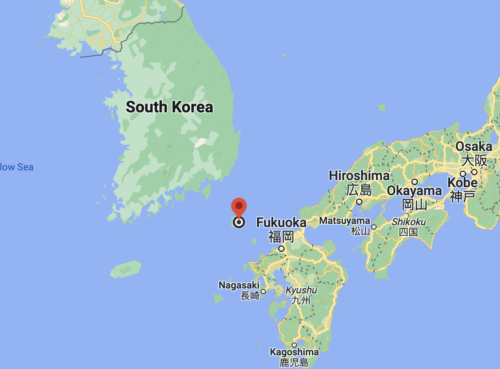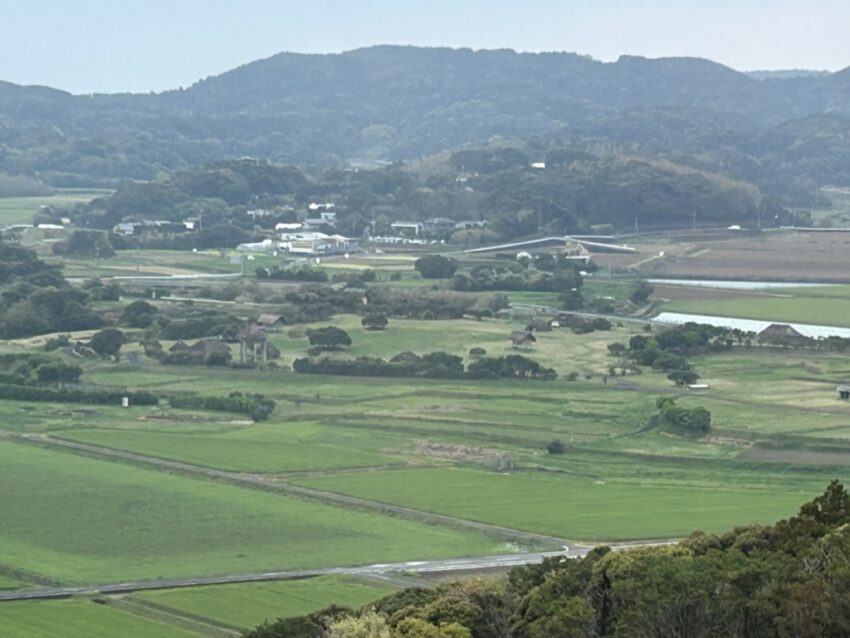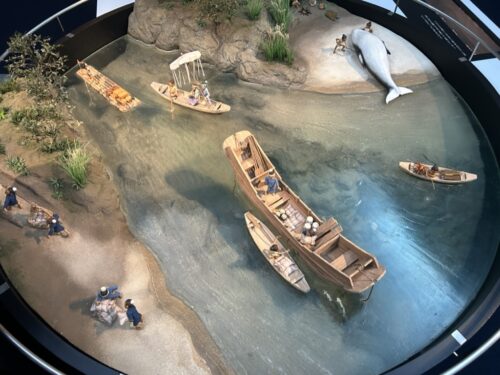
Island Hopping from Korea to Japan: a Journey Crossing Water and Time
By Vicki L. Beyer
Where the East China Sea meets the Sea of Japan, the distance between the Korea and the Asian continent and the Japanese archipelago is less than 200 kilometers.
archipelago is less than 200 kilometers.
In that narrow strait of water stand Japan’s so-called border islands which, for millennia, have served as stepping stones for people seeking to cross between continental Asia and Japan.
My journey followed in the wake of those historical travelers, island hopping across water and time. I embarked from the port city of Busan on the southeastern tip of the Korean Peninsula.
From here it is just 50 kilometers to Tsushima, the outermost of Japan’s border islands. The strait is notorious for its rough seas. In my case, what was supposed to be a one-hour crossing took two hours thanks to high wind and waves.
Most of my fellow passengers were Korean, some traveling for the duty-free shopping opportunity and many in order to fish the waters around Tsushima. Most international tourists in Tsushima are Korean.

From my seat in the center of the ferry at the back, purportedly the most stable place on any vessel, I looked across my fellow passengers and out the windows.
I found that they were first filled with the dark blue of roiling waves, flecked with white foam, and then suddenly only the pale blue-gray of the sky was visible as the ship rolled.
I found it best to simply close my eyes. Judging from the sounds around me, many of my fellow passengers were not so prudent. Eventually, the north coast of Tsushima came into view, rocky and windswept.
Soon we were docking at the port of Hitakatsu. The entire island of Tsushima, about 70 kilometers long and 15 kilometers wide at its widest point, has a population of less than 30,000.
The island is mountainous and, for the most part, covered in forests; people live mostly on the coastal fringes. The soil is poor so the primary occupation is fishing rather than farming.

Even with its international ferry terminal, Hitakatsu is really just a sleepy little seaside village with lots of squid fishing boats bobbing quayside during the day.
On my first stroll in the town, I spotted a signboard explaining that a particularly quiet cove called Nishidomari was favored for stopovers by Korean diplomatic envoys traveling in the eighteenth century.
Later, circling the upper half of the island in a rental car, I found a beautiful white sand beach and lots of cliffs, and a rocky coastline.
A Lopsided Battle Memorial


Just north of Hitakatsu stands a large monument commemorating the Battle of Tsushima, fought between the Japanese and Russian fleets on May 27-28, 1905.
Japanese admiral Togo Heihachiro’s naval strategies brought Japan a decisive victory at the cost of only 117 Japanese sailors, compared to 5,045 dead on the Russian side.
Apparently smoke from the naval battle was visible from this point.
A large viewing platform on the northwestern coast of Tsushima is said to offer views across to Busan; alas not visible on the overcast day of my visit.
Nearby are the ruins of a fascinating first world war gun emplacement. Apparently, the Japanese remained wary of the Russians even more than a decade after defeating them.
Shinto Shrines on the Border Islands
While it is likely that Buddhism was also brought to Japan via the border islands, Shinto shrines far outnumber Buddhist establishments on the islands today.


On Tsushima, many of the oldest shrines are built next to the sea, with one or more of their stone torii shrine gates partially inundated at high tide.
Sumiyoshi Shrine, home to three sea gods who protect travelers, fishermen and sailors at sea, is a popular spot for newly acquired boats to be blessed by the priest. This shrine claims to be among the oldest of the more than 2,000 Sumiyoshi shrines spread across Japan.
Watazumi Shrine, also on the northern shore of Aso Bay, is said to be the site of the Dragon Palace of another sea god and the grave site of his daughter, Princess Toyotama, grandmother of Japan’s mythical first emperor, Jimmu.
I left Tsushima by jetfoil ferry to Iki island, 50 kilometers further to the east. This time the one-hour crossing was smooth and easy.
Although Tsushima and Iki are the two largest islands in the strait between Korea and Kyushu, they are like two different worlds.

Iki is smaller, just 17 kilometers north to south and 14 kilometers east to west, with rolling hills of rich, volcanic soil. Islanders brag that anything can be grown on Iki. That’s probably just as well since much of its coastline is made of up cliffs and there are fewer natural harbors for fishing boats than in Tsushima.
Iki is also home to a substantial number of Shinto shrines accompanied by fascinating myths. Its Sumiyoshi Shrine sits in the center of the island. Legend has it that the gods of the shrine asked for the coastal shrine to be relocated inland so they would not have to listen to the pounding waves.
Iki Was a Major Trading Center
Perhaps because it has always been more agrarian, even in ancient times Iki was a major trading center. The archeological ruins of Haranotsuji continue to be excavated, but it was already clear that this Yayoi Period (300BCE-250CE) settlement on the Hatahoko River half a kilometer from its mouth was a major market town and transit point for envoys traveling between the Asian continent and the Japanese archipelago.
A number of period buildings have been reconstructed in a park on the site, augmented by detailed displays and explanations at the nearby Ikikoku Historical Museum.

The museum also has a replica wooden boat of the kind believed to have been used by those ancient travelers.
I can’t help but think that such a vessel would have been swamped in the seas I faced on my first crossing.
Perhaps the ancients were wise enough not to venture to sea on such windy days.
On Iki there is also evidence of the thirteenth-century Mongol attempts to invade Japan.
Iki’s interior is home to a surprising number of kofun burial mounds from the sixth century. Before the introduction of Buddhist funeral rituals, it was common for community leaders to be interred in tumuli made of massive dolmens covered in earth.
One interesting aspect of Iki’s kofun is that visitors can go inside many of them, their valuable contents (including the dear departed) having been either plundered or removed to museums long ago. There is, apparently an ongoing debate as to whether this type of burial mound was first used in Japan and then introduced to Korea or whether the opposite is the case.
Another smooth hour-long ferry ride brought me at last to Hakata Port in Fukuoka, the largest city on the island of Kyushu. During this crossing I could see various small islands, sometimes just a rocky outcrop topped by a lighthouse.
The Dazaifu area, an easy train ride from central Fukuoka, is known for three things: the archeological ruin of the satellite court, the Dazaifu Tenmangu shrine, and the Kyushu National History Museum. The archeological ruin looks, at first glance, like a grass-covered park with a wide but short flight of stairs in the center.
A wander through the park reveals the foundation stones of various buildings. The layout is similar to Korean royal courts and even Beijing’s Forbidden City.
Doubtless, that design was a deliberate attempt to demonstrate to visiting foreign diplomats that Japan’s imperial court was equal to its cousins on the Asian continent. The site was used from the end of the seventh century until the end of the twelfth century.
Taking the Ferry
Information on the Busan to Tsushima ferry is a little hard to come by (the ferries were suspended due to Covid and only started running again in February. The main ferry company is Korean, Panstar, but their website doesn’t reveal much. I think there is some information here Information on the Kyushu Yusen ferry company, which provides service between Hakata and both islands, is here
 An American-Australian, Vicki L. Beyer has studied and worked in Japan for more than 35 years. She regularly writes about traveling in Japan, especially looking for fun and interesting destinations off the beaten track to share with readers.
An American-Australian, Vicki L. Beyer has studied and worked in Japan for more than 35 years. She regularly writes about traveling in Japan, especially looking for fun and interesting destinations off the beaten track to share with readers.
- Camino Tales: Wine and Memories in Galicia, Spain - July 25, 2024
- Beluga Hunting in Norway - July 20, 2024
- Costa Rica: A Rainforest Chocolate Tour - July 18, 2024





